

Are Hunter Sailboats Any Good? (My Honest Experience)

There are a ton of different sailboat brands in the world today. Trying to decide which one is best, is no easy task. It comes down to a bit of fact and personal opinion, but that’s my opinion.
Hunter is a very well-known brand of sailboats. Hunter sailboats are a good boat depending on your needs and what you will be using your boat for primarily. They were designed as a more budget-friendly boat with all of the basic features needed for good coastal cruising.
The debate about whether a Hunter sailboat is good or not has been going on since the company started and there are a lot of pros and cons out there on the sailboat forums. This article is going to go over Hunters and cover as many of the pros and cons as possible. There will be facts and my personal opinion throughout this article. I just want to cover as much as possible so you will have the knowledge you need when considering a Hunter.

The History Of Hunter Sailboats
In the 1800s Henry Luhrs, a German immigrant, outfitted trading ships. He continued to work on boats his whole life and eventually passed the skills on to his grandson. His grandson was also named Henry and continued the family trade on the Jersey coast, building and repairing recreational and fishing boats. After a while, Henry and his sons started the Hunter Company in 1973 in Alachua, Florida, as a sailboat manufacturer.
Luhrs was the owner of the company, but the early boat designs were done by a man named John E. Cherubini. One of the most recognizable boats of the Hunter legacy is the Cherubini Hunter 30. In my opinion, this is a fantastic boat.
Towards the end of the 1980s, the company did run into trouble. Luhrs was not necessarily running the company at this time, he was out sailing the world and had let a board of management take over. The management team had started to run the company into the ground. They did this by only offering a 1-year warranty, poorly built boats, and terrible customer service for its customers. This would be sure to end any company. Luhrs, with fear his company would go under, decided to return immediately and address the issues at hand. He decided to do a whole restructuring of production and decided extending the warranty from one year to five years would be a good start. Luhrs also hired Canadian designer Rob Mazza in 1991 to take over the design and coordinate the production process. These many steps and others helped get the company back on track.
Hunter is responsible for several market innovations, including their trademark stainless steel cockpit arch and their use of the B&R rig. The B&R rig uses swept spreaders that are usually angled aft, together with “stays” running diagonally downward from the tip of the spreaders to the attachment of the next pair of spreaders to the mast or to the intersection of the mast with the deck, that facilitates a pre-bend of the mast (curving aft).
In 2012 Hunter Marine entered Chapter 11 bankruptcy. The company was sold in August 2012 to David E. Marlow, owner of Marlow Yachts and the name changed to Marlow-Hunter, LLC.
Marlow-Hunter continues to produce sailboats to this day and I must say….they are beautiful designs.
Before we start the debate about whether Hunter sailboats are good or not, let’s look at one or two of their better models.
Cherubini Hunter 30

The Cherubini Hunter 30 is one of the most recognizable Hunters out there today. They were first built in the year 1973 and were made until the year1983. Roughly a thousand of these boats were made and you can find them all over the world.
Here are some more facts about the Hunter 30.
- Hull Type: Fin with rudder on skeg
- Rigging Type: Masthead Sloop
- LOA: 30.40 ft / 9.27 m
- Displacement: 9,700 lb / 4,400 kg
- Beam: 10.17 ft / 3.10 m
I have personally sailed on this boat and I found it to be very solid and a great all-around boat. I sailed it in the Gulf of Mexico and the bays around the area and it was always a great experience.
When sailing it felt very sturdy in the water. I never got the feeling that we were being pushed off course in the slightest. There were also a few times that we heeled over and put the rails in the water and it handled that just fine. From the outside, the boat is very recognizable with its unique design, but the cabin below is quite a common layout and design.
I feel like the cabin resembles most 30-foot boats of that time period. There might have been a touch more space in the overall design than other boats but the look and feel are all the same if you compare it to a Catalina or O’Day of the same time period. That is my personal opinion of course.
Would I purchase one of these for myself? I would definitely consider it. They are a great design and very solid. I don’t think I would have any problems with this boat, whether I was sailing it on a lake or across the Atlantic. Some will say it is not a bluewater boat, but I have read plenty of articles about people actually sailing in the bluewater. It just comes down to the captain and what you are comfortable with.
Let’s look at another type of Hunter, the Hunter 37 Legend!
The Hunter 37 Legend
This boat is a less commonly seen Hunter but still a very impressive one. Warren Luhrs was the designer of this vessel. It was not in production long just from 1986 to 1988, but that doesn’t mean it isn’t a good design. This design gets great reviews from the internet and has a great design for speed and comfort. I have only researched this one and watched videos about it. I would very much like to sail one of these someday, but they are not very common as I mentioned.
- Hull Type: Fin w/spade rudder
- Rigging Type: Fractional Sloop
- LOA: 37.50 ft / 11.43 m
- LWL: 31.33 ft / 9.55 m
- Beam: 12.83 ft / 3.91 m
- S.A. (reported): 704.00 ft 2 / 65.40 m 2
- Draft (max): 6.67 ft / 2.03 m
- Displacement: 14,900 lb / 6,759 kg
To get a better look at this boat please take a look at the video below. It is a quick overview of the boat itself.
After researching this boat, I would very much like to have it. This one has a ton of great features and would be perfect for some long weekend sail trips with a good group of friends. If you find a good deal on this one, I would take a second look.
Let us address one of the bigger issues in the next section, which is the bad reviews Hunter sailboats get.
Why Do Hunter Sailboats Get Such Bad Reviews? Personal Opinion
I have done a lot of research and read a lot of forums about Hunter sailboats online and they tend to get a bad rap. There are a lot of discussions about how they are cheaply made and won’t handle open ocean sailing, but I have seen videos of them handling it just fine. Maybe people have had bad experiences with a Hunter before?
There are also bad reviews on certain designs which make sense. Not every sailboat that Hunter has produced, is something I would consider. That can be said about every boat company. I’m sure even Catalina (my favorite brand) has a bad design here or there. One of the complaints was a Hunter sailboat designed without a backstay. This is very upsetting to some sailors and I would have to agree.
The backstay is what helps hold up the back end of the boom when sailing. Technically the mainsail does this as well but the backstay helps keep the shape much better. I have lowered the sail before without a backstay and you have to be very careful because your boom is going to drop right into the cockpit if you don’t have some other means of support. Some people may have a good reason for no backstay, maybe in a racing condition, but for casual life on the water, I definitely want one.
I wouldn’t rule out Hunters just for this or maybe one bad experience on one, you need to give the Hunter brand a chance. Everybody has an opinion on the internet and a lot of them will be against Hunter sailboats. That’s the internet for you though. The internet can say whatever it wants about anything in this world, even if it doesn’t have good evidence. That’s why I think personal experience is the best evidence here.
Take car brands for example. So many people will say don’t buy a ford or a chevy or dodge because it will break down on you. To be clear, every brand of car has had models broken down on them. It is not necessarily the brand, it’s the improper care of the vehicle or a random breakdown of an engine part. The brand itself still makes good vehicles you just had bad luck.
That is why I say you need to try out a few Hunters before claiming them to be a terrible boat.
The last thing I will say about this subject is that I have met multiple Hunter sailboat owners and they have loved their boats. I have not met one captain who owned a Hunter and did not like it. I only found out about their bad reviews by going online and researching them. Take all of this with a grain of salt though, I am just giving you my honest opinion. Check out the video below for another opinion on Hunter sailboats. This is a great video, be sure to check out his channel as well.
Final Thoughts
This article talked about Hunter sailboats and if they are any good. The history of the Hunter brand was discussed and is currently named Marlow-Hunter because the Marlow Yacht company purchased Hunter in 2011. We discussed the Cherubini 30 and the 37 Legend, both of which are great boats in my opinion. That was a big topic in the last section of this article, opinions. Everyone is entitled to their opinion, and that’s what keeps these great sailboat discussions going. We need these great discussions to keep going and fill our minds with as much knowledge as possible. Get out there and talk to people with Hunter sailboats to get the most information you possibly can. I hope this article provided you with some Hunter knowledge to help you in your sailing life. Cheers!

Boatlifehq owner and author/editor of this article.
Recent Posts
Sailboat Racing - Rules & Regulations Explained
Sailboat racing, a blend of skill, strategy, and adherence to intricate rules and regulations, offers a thrilling and intellectually stimulating experience on the water. Navigating through the...
What is the best sailboat to live on? Complete Guide
Embarking on the journey of living aboard a sailboat requires careful consideration of your budget, desired amenities, and storage options. This guide offers a concise, step-by-step approach to...

- Forums New posts Unanswered threads Register Top Posts Email
- What's new New posts New Posts (legacy) Latest activity New media
- Media New media New comments
- Boat Info Downloads Weekly Quiz Topic FAQ 10000boatnames.com
- Classifieds Sell Your Boat Used Gear for Sale
- Parts General Marine Parts Hunter Beneteau Catalina MacGregor Oday
- Help Terms of Use Monday Mail Subscribe Monday Mail Unsubscribe
Just How Good Are Hunters?
- Thread starter Caribbeanknight1
- Start date Aug 1, 2013
- Hunter Owner Forums
- Ask A Hunter Owner
Caribbeanknight1
I realize I am asking a biased audience but I know many here have owned other makes of sailboat. I have only limited sailing experience but I have been so impressed with my H240 vs the other boats on the lake. I know Hunter are considered "production boats" but you get so much boat for the price and they seem to sail as fast as anything in the same class yet the simplicity of the boat allows a beginner like me to sail like a pro. What am I missing? Where do Hunters not stack up to the much more expensive competition?
When crossing an ocean. Hunters can do it and do but most prefer a blue water boat. Many can argue this subject but Hunters are not "blue water boats." I love mine and it is great for coastal cruising. However, I would not want to cross an ocean in it.
Consider this that Ferrari cars are "production cars" even though they may make only twenty-four of that model. I'm in the September of my years now and have grown up with sailboats since the late nineteen fifties. I've had ten new boats, the last five have been Hunters because of the quality of construction that I have observed. They are a good company and made in America. Years ago at the beginning of the dawn of fiberglass right after WWII, sailboats were hulls with decks and minimal interiors. When you looked under the interior seats of the Cal there was raw fiberglass. The hot boat at that time was the plywood Thunderbird or T-bird, an excellent 26 footer that could be built at home. It took a while for sail boat companies to learn how to design and use fiberglass. And building the interior was a work of art with each piece of wood being measure for that individual boat. Some companies still build their boats that way but it is labor intensified. Some of our boat companies couldn't compete with the Asian boat companies with their cheaper labor and we began to import Fugis, Yamaha's, etc. So our boat companies responded with learning how to build boats like old Ford cars with every piece fitting every boat on the line. A company could cut ten pieces for ten boats at one time and have them all fit. Hunter was one of those companies that lead the way in modern day boat construction. But one of the things that convinced me to buy Hunter was their program of checking back with owners and asking what is working--what is not working. Then they would make adjustments in the plant and construction of their new models. I have watch improvements on all of my five Hunters. I suspect the new models are even better and have passed me by. "How can we make it better" seems to be the mantra of Hunter company and indeed, they have been one of the most innovating boat companies during the past twenty five years. Look at the B and R rid, roller furling mains and jibs, sugar scoop sterns, "tourist" seats in the stern, and the list goes on. Even where you can't see things they made improvements such as all plastic tankage or all through hull fittings in one place accessible for checking. Some of these same innovations and/or improvements you cannot find on some of the more expensive boats....however individual perception is a fascinating study. To complete my point, I drive a Subaru Forester which gets me to the store quite well. Would I like a Ferrari? I'm sure I would have fun going to the store in one but I doubt if it would get me there quicker (we have stop lights in my town) or anymore comfortable..... I suspect I would enjoy the purr of the Ferrari motor or the smell of the interior. I suspect I could enjoy sailing an Oyster sailboat but quite frankly I am in love with my Hunter 27. At my age it is a delight to sail and I can sail it by myself. And I don't have to repair or add items to make it sailable. It may be that the owner of a Ferrari will look down at me as might the owner of an Oyster. But the end result is that I'm having as much fun as they are sailing. So if you think your H240 is well made, you are correct. If you think your H240 is a good investment, you probably are correct as well. The end result is how much you enjoy sailing and cruising in your boat. I hope you get as much satisfaction from your Hunter as I do mind. I wish you well. By the way, I'm eighty in years and have sail many, many boats over the years. I still think of my Hunter 27 as a MGA of the boating world....a fun boat.
I am new here and just purchased a 2006 Hunter 33.1. I have owned an ODay 25, a Hooks Marine Custom 34,Heavy Bluewater Boat. and also own a Nimble Nomad. Sailing for over 20 years. I do my own work and have read several books on boat construction. I was a Machinist Mate in the Navy and operated a 1200 lb Super Heated Steam Main Propulsion engine room. A Hunter is a production boat which seems to have it's fair share of detractors but from what I have seen and inspected it is a well built boat. The boat I bought had a owners manual which detailed every system on board in detail, which is not something I saw on any other boat, I also found the manual on line. All thru hulls are centrally located easy to close which is what you should do when you leave the boat. I found all the equipment installed up to the intended and installed properly. BTW I am perfectly qualified to survey the boat myself but hired a qualified survey to do a survey and he found no construction issues and only minor gear issues. I had used the same surveyor last week on a Catalina 30 which I walked away from at a cost of $800.00 for survey and lift, money well spent. Bang for the buck the boat is a great boat. As on all boats you have to balance the boat you buy with the intended use and your skill level. Good luck on your hunt for a boat, sometimes it takes time to find the boat that loves you. Jim
Les said: I still think of my Hunter 27 as a MGA of the boating world....a fun boat. Click to expand
The Italians do not use Ferraris to go to the store either, they keep them in the garage and drive a Fiat. Each engine is hand assembled by a single highly trained and experienced individual. The seats are hancrafted from selected cuts of leather. That is not a production automobile. The use of computers has revolutionized manufacturing processes, we can now reach tolerances that before were to expensive to achieve. The difference observed between specialty builders and production manufacturers mostly rest in the quality of the materials being used and the quality controls. While the first may accept the cost of having to redo a job the other may decide to overlook it. Ferrari engine blocks undergo rigorous testing with a rather large percentage being scrapped and the metal recycled. The quality on production automobiles and boats has been improving but there are still a number of lemons reaching the marketplace. Don't get me wrong Hunter puts out a "Ferrari" of a design, uses good matrials and good components and price the boats fairly. Production errors that do not affect the safety of the boat are routinely overlooked but that is the tradeoff we are willing to accept between Price and Quality.
Crazy Dave Condon
The Hunter water ballast sailboats were designed for the trailerable sailor as I was very much involved with them from the start. The 23.5 is my baby and I outsold all other dealers of the 240. I also sold Catalina, Beneteau, ComPac, Precision, MacGregor and many others over the years. I have heard all the Fiddlesticks about boats and so on. All to include the Hunters have their good points. When you say this is a blue water boat of course referencing the 240, it was not designed to cross an ocean. As to a productin boat, well guess what, so are the rest of the crowd as I have been in all the plants except for the MacGregor. If the two of you want to contact me, please feel free thru the forum email and I will be glad to help. My info is based on information and experience. crazy dave condon
Not "blue water boats"? Don't know about the newer Hunters, but I bought a Cherubini 37-C specifically to be my "blue water boat". It's built like a tank and reported by far-too-many-to-ignore owners as surprisingly fast. I wouldn't think twice about cruising the oceans in Fred V - the boat is fine, it's the captain that's questionable!
FredV said: Not "blue water boats"? Don't know about the newer Hunters, but I bought a Cherubini 37-C specifically to be my "blue water boat". It's built like a tank and reported by far-too-many-to-ignore owners as surprisingly fast. I wouldn't think twice about cruising the oceans in Fred V - the boat is fine, it's the captain that's questionable! Click to expand
Hunter Quality I spent the last year repairing and replacing parts on my 2002 H456. Eighty percent done by professionals and everyone of them from the diesel mechanic to the electrical engineer to the plumber has commented on how well this boat is built and with quality parts. Just be prepared to add 50K of offshore equipment and go where you want to go.
wifeofgonzo
A Biased Reply I have a 2005 Hunter 36. In my opinion, the 36 is one of the best designed boats Hunter has made. I agree that the company does listen to owners and make changes. Lately it is their downfall. Go to the sail show - I don't think anyone leaves the dock. No storage space, difficult to do things underway, all designed to be at the marina not on the hook. Finding the right boat boat is like buying house. You know when you're "home". New is just as much of a pain as not, still bugs to work through. Our friends spend more time fixing their brand new Beneteau than sailing. I also agree I would not take our boat blue water. Not because she isn't seaworthy, but because of the keel. She is perfect for the coastal cruising that we do. Easy to single hand, perfect for two to be very comfortable, but big enough for friends to join us every now and then.
John Murphy
CRBKT 1, I looked at all kinds of boats from Fla,to Apls, to New Eng. in the 37-40 range. I stayed away from Hunters 'cuz of my late 70's experience w/ them where they were a "Package Boat": carpeting not only on the cabin sole but UP THE BULKHEADS & ACROSS THE CEILING !!! REALLY!!, & a plastic "garbage bag" filled w/ 2 PFDS, some lines & a couple other items that made it; "Ready To Sail". I bought an Ericson back then & loved the John Holland designs & quality materials ( real, thick teak not vinyl over plywood ) & craftsmanship. Had it 30+years. Anywho, I had to swallow my pride & got a rude come-uppance. I bought a 1997 Hunter 376!! : o Learned it had been The Boat of the Year!! I am constantly comparing it w/ similar Catalinas ( who also have come a long way since the 70's) & Benateaus,etc. $ for $, spaciousness, brightness below ( Benateaus are "bat caves"), comfort, ( the pass-thru stern stateroom ( 2 doors, to galley & head ) surpass the other boats. I'm a USNA Offshore Instructor & USPS Safety Officer. I agree w/ my fellow sailors that Hunters are NOT Offshore boats, but Coastal Cruisers. Mine has been to Maine & back & all over the Chesapeake Bay, whose summer squalls can get pretty nasty. They're not Tartans, nor Sabres, but if you're not going Offshore, they're a GREAT boat. "Fair Winds & Following Seas...." " Murph "
I have one of those 1970's package Hunters, a 1977 30 with the carpet everywhere. These boats were built to meet a price point and they did. They were well made and still do what they were intended to do. Amazingly much of that carpet is intact and as she is a dry boat not moldy and while not as attractive as teak, its ok. I sail the boat not its interior and more than 36 years after she left the factory she is still a fast boat for her class. My crew member who owns a Catalina 30 marvels over the standing room and comfort below. She is no Ferrari, she will never cross an ocean but she gets me a round the Cheaspeake and the Delaware and that's what I bought her for.
My first boat was an 85 Hunter 25.5. I also looked at the 24 foot ODay but liiked the separate bulkhead going into the V berth on the Hunter, making it seem bigger. . It only drew 3'3', you needed a porta potty but it sailed well. When looking for a newer boat, I was directed to both Catalina and Beneteau. Both nice boats but I liked the style and the amount of light coming thru on the Hunter along with the lighter wood. The boat sails great, even in higher winds and the in-mast furling doesn't cost you a lot of speed. I frequently get over 7 knots and topped out at 8.4 kts. It does have the North Sails. Boats are personal preference but I'll put the Hunter up there with the other producton boats anyday.
- This site uses cookies to help personalise content, tailor your experience and to keep you logged in if you register. By continuing to use this site, you are consenting to our use of cookies. Accept Learn more…
Hunter 44 Deck Salon Review

We know that the modern production cruiser and cruiser/racer owe everything to racing yachts. Hull forms, keels, construction media and, particularly, rigs and control systems have been handed down directly from both crewed racers and short-handers. Every time you bless a furler, or an autopilot, think back to those pioneer solo sailors struggling through Atlantic gales in the 1960s and 70s, with sleet in their beards and eyes peeled for icebergs. Nowhere is the lineage more direct than in the US-built Hunter range.
Warren Luhrs, a fifth-generation boat builder from the US east coast, won the 1984 OSTAR (solo Transatlantic Race) in Thursday’s Child, the boat some people claim was the first modern solo racer as it had a light and beamy hull, water ballast and heavily-roached fullybattened mainsail. Hunter Marine is part of a group known as the Luhrs Marine Group, which includes several powerboat lines “the Luhrs family’s stock in trade for generations” which includes the Mainship trawler yachts also sold in this country. Warren started Hunter in 1973; the range now begins with a 9ft Optmist-style trainer costing $US1999, and tops out at a 50-footer.
There are two big TYs with water ballast (dump the water and save trailing weight), but the Hunter line’s external trademark is the Bergstrom & Ridder rig which has no backstay, heavily-swept spreaders and a big-roach fully-battened main, a direct descendant of the rig on Thursday?s Child. If you have survived the lecture (wake up, there will be a test later) let me confirm my point ? at some point Warren must have recognised that the stuff that worked on his race boats to make them easy to sail, would work on production boats too. In doing that he ignored American tradition, which shows a cautious approach to adopt advanced, or unfamiliar technology, because the home market is so conservative. Americans invented the transistor, but it was the Japanese who exploited it and made all the money along the way.
LAYOUT Let’s get back to the subject in hand. The Hunter 44 Deck Salon is a big-volume hull with a higher coachroof profile than its sister (the Aft Cockpit Cruising Version). It has a fin keel (shallow draught is an option) and features the deck-stepped B&R rig, with swept-back spreaders and plenty of diagonal support. The shrouds are fastened to the hull sides, while the lower shrouds and the struts supporting the gooseneck area meet at the deck and connect to struts below decks which in turn feed loads into the hull. A band of fibreglass reinforcement spans the hull, from gunwale to gunwale, picking up the chainplates, keel and mast step area.
The hull is a mix of solid laminate and balsa core. The mainsheet traveller is on a stainless steel Targa bar over the cockpit; the bar also carries the optional bimini. Below deck is a vast, well-appointed apartment, with lots of traditional teak trim, a style which is currently out of fashion with European builders. These things come in cycles; teak will be back. The forecabin has three optional layouts; this boat has a double berth on the port side. The forward head, which includes a shower, is en suite with the forecabin. The main saloon is conventional, galley to port. There’s a big dinette table which lowers to sleep on, plus a large settee to starboard.
There are a couple of stainless grab rails, vital in such a big saloon as you could fall a long way. The area aft of the main bulkhead can be two cabins or, as in this boat, a huge stateroom which spans the width of the hull. The inner spring queen-sized bed is fore and aft and offset a little from the centre. It is, in effect, beneath the cockpit trench. In some arrangements like this you can hit your head on the overhead mouldings if you jump out of bed, half asleep. Not on the Hunter, there is so much freeboard aft there is plenty of headroom.
This is not a cabin, it is a room, like a hotel bedroom, bigger than many I have stayed in and better appointed. It has its own door to the main head; another door in the cabin enables this to be the day head too. The head has a separate shower area, with bi-fold glass doors and a gap between the top of the walls and the roof. This is a very good idea because a number of women I know, and many others, get claustrophobic in small yacht shower rooms. True. Throughout the boat are storage areas far too numerous to mention. There are lockers and drawers and bins and shelves everywhere, surely more than other production boats of this size.
The result of all the features is a remarkable level of comfort (as opposed to high style, or opulence), which must be appreciated by family members less committed to life afloat. One little feature, behind two small glasspaned doors alongside the sink you will find the dish draining rack, so it is (a) hidden and (b) you can probably even sail while the lunch dishes dry. This Deck Salon has a level of comfort, which becomes luxury. The converse is not always true; you can have the luxury, but not necessarily the comfort. Edward Penn, from importer US Yachts (an offshoot of the Sydney by Sail charter company) shows me the Hunter 44’s piece de resistance.
The great conundrum of production yacht design “how to make an easy walkway for humans past the steering position to reach the stern” has been solved by Hunter with what I modestly claim to be the design breakthrough of the century. The wheel rim folds; simply lock clamps on the spokes and parts of the wheel rim fold away so you can walk past easily. The boat can be steered at the same time. This wheel is an option, but that is the first box I would tick on the order form. The cockpit is wide and long enough. The hardware is all good gear, winches by Lewmar, spars by Selden and all the deck gear is by Harken.
ON-WATER PERFORMANCE How does she sail ? The fully-battened main lives in boom bag and lazyjacks; a mast-furling main is an option. Press the button on the single electric winch on the coachroof (an option) and the heavy main slides up easily on its batten cars. The main sheets to the primary winches on the stern are within reach of the helmsman. Jam the main halyard and the coachroof winches handle the headsail sheets. The rig is 7/8, so the jib is not too big and is easy to sheet home if you time it right. We saw 6.2 knots upwind in 11 knots of True wind, then 6.6 in 12.5 and a steady topspeed reading of 6.8 knots in 14 True with the wind indicator needle in the low 30s, not bad for a cruising boat with a fixed threeblade prop.
One small criticism; because the headsail winches are on the coachroof, the helmsman cannot tack the jib. The helmsman has to steer from the leeward side to see the headsail tufts. The steering is by a Whitlock rack and pinion steering system, which is used by a number of builders and is perfect in every hull, weight and gearing are just right. You can tell, because a new helmsman adapts instantly; there is no wheel twiddling to work out the gearing, you get it right first time you wriggle the wheel. The 56hp Yanmar is quiet; there is a little prop walk to starboard in reverse, but you can put it to good use when familiar with it.
OVERALL The Hunter 44 Deck Salon is good value. Base price is $420,000, but most buyers would add a few options. However, the boat we sailed cost $495,000, because the owner had specified the deep keel, halyard winch, airconditioning, a 4hp bow thruster, generator, bimini and, of course, the folding wheel, as well as other stuff. An average spec would fall between the two. The owner gets a lot of boat both in volume and equipment. Hunter does not pretend this is a cruiser/racer “a folding prop is not an option” but it is responsive to sail and the hull is slippery. You could live onboard for long periods of time because of the hull size and the level of appointments. A long way from Thursday’s Child and not so far at all.
Words by Barry Tranter

Hunter 44 DS perfect to live aboard!

This 2007 44 Deck Salon features great headroom, with a very large salon, an L shaped galley, 3 staterooms each sleeping 2 people, and 2 heads, each with shower stalls. The boat is very well laid out and ready to have the last few details finished before Caribbean cruising! It is in Melbourne, FL on the intracoastal currently, and is undamaged from Hurricane Ian. The previous owner replaced both the Yanmar 54hp main engine and 5.5. KW diesel generator in 2107, so each has less than 300 hours. The engine also has a new transmission in 2021. The genset easily runs the 2 air conditioning units on the hook or underway, which work great with the shades to cool the boat. The previous owner replaced the roller furling main mast before I bought it, and a spare set of sails is included. (Jib also roller furls). The sanitation hoses to the two electric fresh water Jabsco heads were replaced in 2020. Two TV's with DVD players built in allow entertainment off the house batteries for a quiet anchorage, secured by a 70 lb. Danforth with all chain rode. The electric windlass works great with the new roller to get underway for a 7 knot cruise speed under a full canvas dodger, and the two bench seats on the dingy davits keep your guests close to the action without being in the way. The boom is well above the sturdy tube superstructure, so no headaches are in store for beginning sailors! Text Ron 321.759.6433 for more info, thank you. Reasonable offers only.
Sailboat Details
Contact listings owner form, related listings.
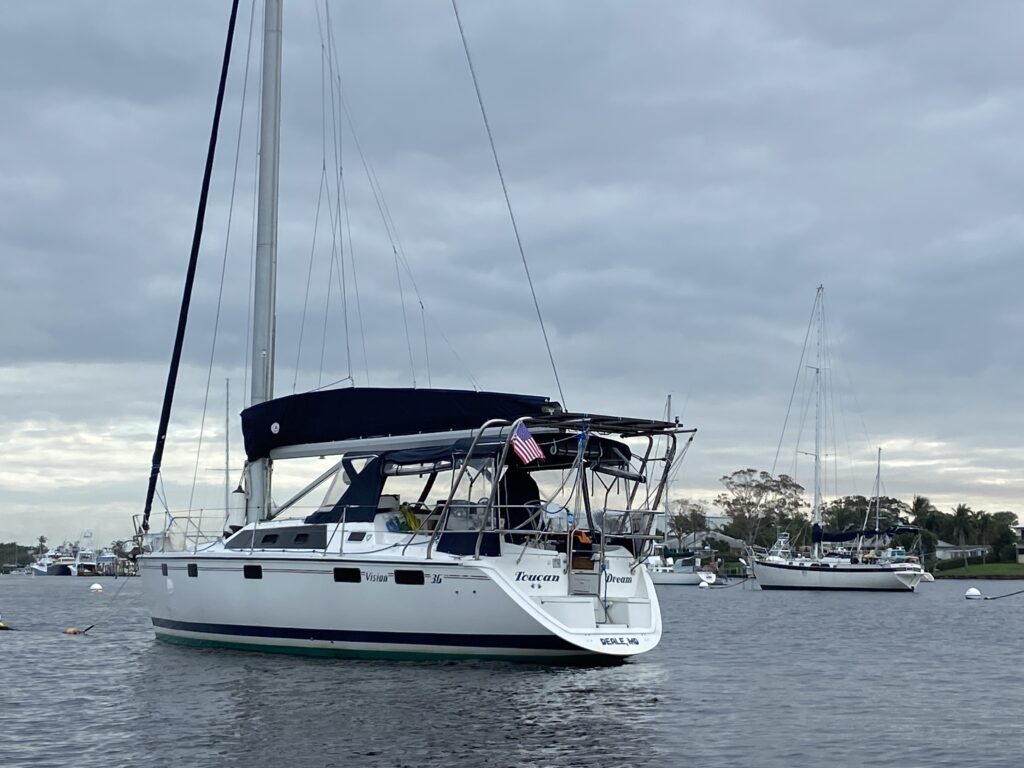
36 Hunter Vision 1993

Hobie Mirage Tandem Island

1972 Luders 36 by Cheoy Lee
The Sailor’s Marketplace for Sailboats and Sails.
Sell Your Sailboat
Sailboats for sale.
- New Sailboats
- Used Sailboats
- Cruising Sailboats
- Racing Sailboats
Sell Your Sails
Sails for sail, sail manufacturers.
- North Sails
- Quantum Sails
- Doyle Sails
- UK Sailmakers
Sailing Reviews
- Sailing Line
- Safety Equipment
- Sailing Accesories
As an Amazon Associate SailTrader earns from qualifying purchases.
This website uses cookies to ensure you get the best experience possible.
Roads Less Traveled
Are you dreaming of rv living or the sailing life we've been doing it since 2007 and we have lots of nomadic lifestyle tips and stories for you.

2008 Hunter 44DS Sailboat
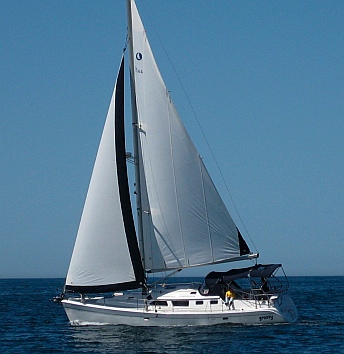
Groovy - '08 Hunter 44DS
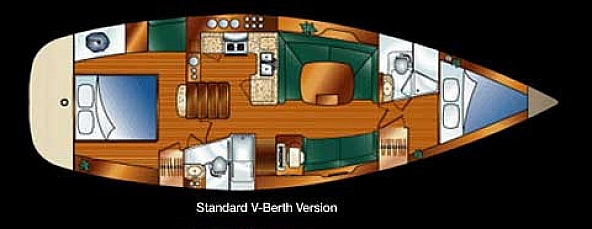
Hunter 44DS Floor Plan
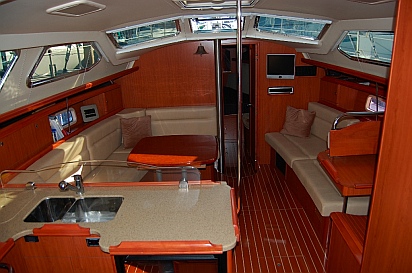
Main salon.
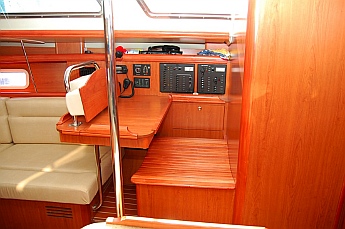
Navigation station.

Master stateroom.
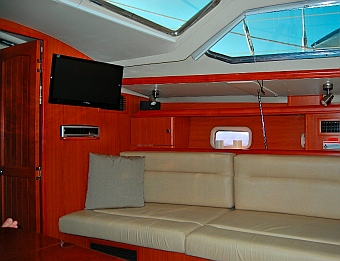
Long settee for napping.
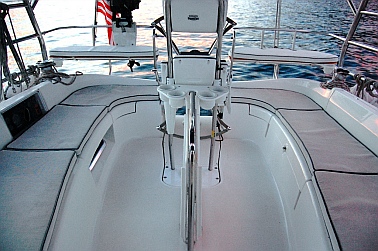
Spacious cockpit. We can sit face-to-face with our legs
stretched out, and our feet don't touch.
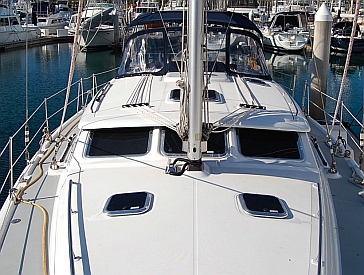
Sitting inside on the companionway stairs, you can see where you're going, a wonderful feature on a
cold overnight passage.
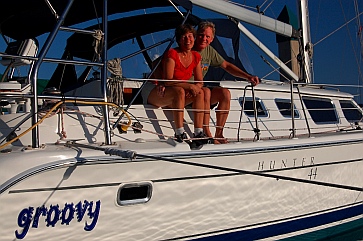
It's just a groovy boat.

Twizzle Rig - twin headsails flown on
matching whisker poles.
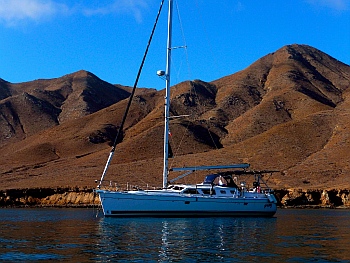
At anchor in Bahía Santa Maria, Mexico.

Under sail.
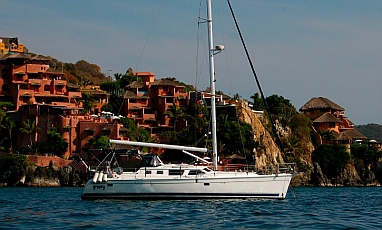
At anchor in Zihuatanejo, Mexico.
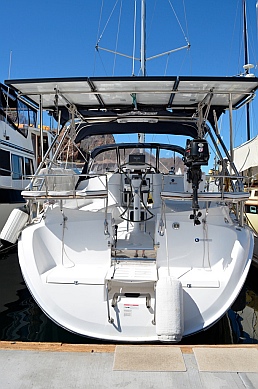
Three 185 watt solar panels provide
awesome shade over the jump seats
Hunter 44DS Sailboat: s/v Groovy
Groovy has been sold. Pics, listing and Sales Spec Sheet here!!
Groovy (named for Simon & Garfunkel's song Feelin' Groovy )** is a
Glenn Henderson designed 2008 Hunter 44DS (Deck Salon). A
fractional sloop, it is 44 feet long and 14' 6" feet wide with two
staterooms and two heads.
Hunter 44DS Model History
First introduced by Hunter Marine in 2002 as the Hunter 426, the aft
cabin was changed a little and the model name changed to "44DS" in
2003. Production ran from 2003 to 2008. In 2008 the the deck and
cabin were modified to accommodate twin helms instead of a single
helm, the forward berth was changed from a v-berth to a pullman style,
and the window pattern was changed to a wraparound band to match
the popular Hunter 45CC. These changes saw the model name change
to "45DS," and as of 2012 it is still in production.
Along with the Hunter 426 and 45DS, the 44DS shares its hull with the
Hunter 44AC (Aft Cockpit) and Hunter 45CC (Center Cockpit). Each of
those boats has the same hull but a different deck and cabin layout.
Groovy is hull #252 for the 44DS model line, where the numbering
started at #101. Built in May, 2007, it was the last Hunter 44DS ever
built. Click here for more information on the Hunter 44DS.
Groovy is a stock boat with Hunter's "Mariner Package," a collection of upgrades sold as a unit. Because the boat was built after
the replacement model (45DS) was in production, it features a few of the components that are standard on that model, including
a laminate cherry interior, which we love, and a larger fuel tank, which has come in very handy.
Specifications
Length Overall (LOA)
Waterline Length (LWL)
Displacement
Mast Height
975 sq. ft.
Fuel Capacity
Water Capacity
140 gallons
Holding Tank Capacity
Water Heater Capacity
Yanmar Diesel Engine
CE Classification
We installed many upgrades to enable comfortable cruising where we can stay at anchor for months at a time without having to
rely on marinas for water or electrical connections.
House Batteries
640 Amp Hours (Four AGM 4D 12 volt) - plus one 70 Amp Hour AGM start battery
555 Watts Solar / 100 Amp Alternator on engine / 130 Amp 110v Charger (via shore power)
600 Watts Pure Sine Wave / 2500 Watts Modified Sine Wave / 2 portable Modified Sine Wave
60 Gallon per hour engine-driven Echotech watermaker*
Downwind Sailing
Twin jib "Twizzle Rig" set on two fixed length whisker poles.
60 lb Ultra primary with 300' 5/16" G4 chain
32 lb Fortress FX-55 secondary with 20' 5/16" BBB chain and 300' 7/8" Nylon Rode
15 lb Manson Supreme stern anchor w/ 5' 3/8" G4 chain and 230' 1" Nylon Rode
10' Porta-bote with a Suzuki 6 hp outboard
Hobie i14t tandem inflatable kayak
A GAZILLION BOATS FOR SALE... WHICH ONE
Would make us happiest.
When we set about buying a boat, the major trade-offs we found
were age, size, price and manufacturer's prestige. In an earlier life I
owned two boats back to back that were the exact same model, the
Nonsuch 36. This is a wonderful boat for cruising and living aboard,
and I lived aboard for four years in Boston, Massachusetts in the
early 1990's (brrrr...those winters were cold). The first year I was on
a 1984 model that had been ridden hard and put away wet. After
watching in great distress as my then-husband repeatedly chased
down a spider web of unmarked cables and miles of smelly plumbing
hoses in a putrid bilge, we upgraded to a 1991 model of the same
boat that had been lavishly commissioned and meticulously
maintained.
What a world of difference. You would never know they were the same
model boat. Instead of him spending hours kinked up in impossible
positions in noxious nooks and crannies fixing problems and spending
boatloads of money on spare parts at West Marine, we enjoyed three
terrific summers of boating together. We watched sunsets and sunrises
in pretty anchorages and experienced countless utterly brilliant days of
sailing. There is nothing like an almost-new boat made up of sparkling
clean parts that work. Therefore, when Mark and I started thinking about
buying a boat, our first two criteria were that it be in superior condition
and as new as possible.
After living in trailers full-time for so long, we also knew that size
mattered to us. For full-time liveability, we found bigger is better.
With age and size the top priorities, and a maximum budgeted
price, there were only three manufacturers whose boats we could
afford: Hunter, Beneteau and Catalina. These are the Ford-Chevy-
Dodge of the sailboat industry (not in any particular order). All
three are American made. Beneteaus are French designed but
built in South Carolina. Hunters and Catalinas are designed and
built in Florida.
Our top priorities for livability included a huge cockpit where we could
stretch out to sleep, a long settee in the main salon where we could
nap, and two good sized staterooms (rather than three as in many
models). Brokers thought we were crazy when the first thing we did
as we stepped aboard a prospective boat was to lie down in the
cockpit to see if the benches were long and wide enough to sleep on.
But hey, this boat would become our home, and we like to be
comfortable and relax!
Next in importance was a large swim platform and cockpit shower, as
we envisioned frequent swims off the back of the boat and we knew
we would need easy access to the dinghy when we lived at anchor,
especially hauling groceries, daypacks, trash and laundry bags in and
out. Lastly, we wanted an airy, spacious interior. Other than that, we
weren't fussy, but after attending dozens of boat shows, visiting fifty
or more boats with brokers, and many Caribbean charters, we found
that the Hunter models spoke to us more than the others, and of
those only the Hunter 41DS and 44DS made the cut. The faltering
economy worked in our favor, suddenly making the larger of the two
boats a viable option.
A visit to the Hunter factory assured us that not only are their boats
cleverly designed and chock full of innovative features, but they are well
built to boot. We came away from every contact we had with Hunter
impressed that it is a quality company that employs a loyal group of
happy employees. Their phenomenal customer service since we
purchased Groovy (15 minute turnaround time on almost every emailed
question we've ever sent) has driven that point home to us time and
again. Hunter sailboats are the boating industry's best kept secret.
Best of all, Groovy is a dream to sail. With an easily driven hull,
the boat is light on its feet, easy to reef, responsive and
forgiving. A delight to live in and fun to sail, it is an excellent
platform for extended cruising.
** When we named our boat, it was the only boat with the name Groovy in the US Coast Guard Documentation database. So we
were quite surprised when we discovered over a year later that she has a sistership of the same name bearing a non-US flag:
Jimmy Buffet of Margaritaville fame races his Groovy in the Caribbean. Far out!!
*Echotec's official "rating" is 40 gph, but since we installed high capacity membranes, our timing measurements have never
been less than 58 seconds to fill a one-gallon jug in the tropics (the speed is 44 gph in San Diego's cooler water).
More info in the links below...
The following clip is a VIDEO WALKTHROUGH of our boat which we did before it was sold:
Subscribe Never miss a post — it’s free!
Our 555 watt solar power system is described in detail here: Sailboat Solar Power System . There is lots more info about solar power solutions for boats and RVs here: Solar Power Articles for Sailboats and RVs .
Our 60 gallon per hour engine driven watermaker was featured in an article we wrote for Cruising World Magazine. The article can be read at this link: Water, Water Everywhere – Installation of a 60 gph engine driven watermaker .
Our cruising itinerary and all of our blog posts from our cruise can be found at this link: A Groovy Cruise of Mexico .
There is a ton of info on this website about planning a Mexico cruise and anticipating what to expect . To get oriented and find out where we keep all the good stuff, visit this link: Cruisers Start Here
Volume 1 reviews the geography, weather and seasons in Mexico and shows you what the best anchorages between Ensenada and Manzanillo are like.
Volume 2 gives detailed info that can't be found in any of the guidebooks about the glorious cruising ground between Manzanillo and the Guatemala border.
Volume 3 (right) provides all the info you need to get off the boat for an adventure-filled trip to Oaxaca.
- Latest Posts
- Solar Power Articles
- Battery Articles
- RV Vent-Free Heater
- Trailer Disc Brake Conversion
- Buying a Truck for Towing
- Buying a 5th Wheel for Full-time RVing
- 5th Wheel Hitch Installation
- Truck Engine Tuner
- 5th Wheel Suspension Overhaul
- RV Dump Station Tips
- Add RV Storage Space
- RV Tips & Tricks
- Travel Photography Tips
- Product Reviews
- RV Budget & Expenses
- Winter RVing Tips
- Living & Working in an RV
- Going Full-time – Which RV?
- Full-time RV Lifestyle Tips
- What Is An RV Warranty?
- RV Warranty Case Study 1
- RV Warranty Case Study 2
- RV Warranty Case Study 3
- Internet & Phone Access
- How to Boondock
- Finding Boondocking Sites
- Dental Care in Mexico
- Our Rigs…
- Cruising Mexico Video Series
- Planning Your Cruise…
- What to Expect on a Mexico Cruise…
- Our Cruising Blog Posts…
- Our Groovy Sailboat
- Massachusetts
- Mississippi
- New Hampshire
- North Carolina
- South Dakota
- National Parks
- Baja California Coast
- Northern Mainland Coast
- Southern Mainland Coast
- Sea of Cortez
- Mexico INLAND Destinations
- Canada Destinations
- Caribbean and Guatemala
- Thailand and Cambodia Travels
- Travel Itinerary & Route
- 10 Year Overview – Part 1
- 10 Year Overview – Part 2
- About Us & Contact
- Order from Amazon
- OUR GEAR STORE!!
- BOAT OF THE YEAR
- Newsletters
- Sailboat Reviews
- Boating Safety
- Sailing Totem
- Charter Resources
- Destinations
- Galley Recipes
- Living Aboard
- Sails and Rigging
- Maintenance
- Best Marine Electronics & Technology

Hunter 426 DS
- By Darrell Nicholson
- Updated: May 28, 2003
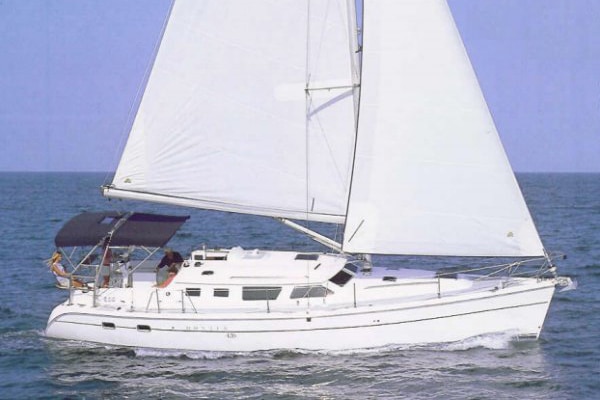
On a morning last February, when half of the country was getting hammered by another winter storm, I was coasting off Miami Beach aboard the new Hunter 426 Deck Saloon (DS) sloop. Sunburn was my biggest concern. As if that weren’t enough reason to feel smug, the 426 DS was reaching at 5.3 knots in true wind speeds of 10 knots or less. On a day when most cruising sailors would be tempted—if not forced—to reach for the ignition key, we found ourselves contentedly making good time toward Fort Lauderdale.
At this rate, I figured we’d cover the 23 miles or so in plenty of time for lunch.
With a molded brow over her tinted windows, she looked the part of a purposeful vessel. Aimed at a broad range of sailors, the 426 DS—also available without the raised deck as the 426 Aft Cockpit—faithfully finds a sweet spot between price, performance, and comfort. Priced at just over $200,000, the 426 will no doubt hold great appeal for sailors who don’t want their weekend sails or summer getaways spoiled by lazy breezes. And for a dockside liveaboard who can’t bear to part with the comforts of land life, the boat is chockablock with familiar appliances, creature comforts that are above the standard that you’ll find on many boats in this price range. When it comes to meeting popular aspirations at a price we can live with, Hunter’s streamlined production process gives it a great advantage.
Small-output builders who produce a dozen or two boats a year focus on a niche, with reasonable assurance that if they deliver the right combination of features and quality, they’ll find the buyers they need. Being one of the “Big Three” sailboat builders in the North American market—Catalina and Beneteau are the other two—Hunter Marine is able to reach beyond the specific niches of cruising-boat buyers and appeal to a broader customer base.
In the last two model years, Hunter Marine has racheted up its boats’ value, and much of the effort has been made in the areas of accommodations and onboard amenities. On going below on the 426 DS, the results are readily apparent. Built with modular manufacturing techniques, the interior features a veneered- panel ceiling, a technique that ties the components together visually while giving the main cabin a subtle warmth.
Generously sized and well laid out in a practical L-shape, the galley is nicely fitted out with a two-burner stove and twin deep stainless-steel sinks set in Corian countertops. Its convenience is enhanced by the ventilation provided by two opening ports, a hatch, and the proximate companionway. The refrigerator and freezer are under-counter, custom stainless-steel units that offer the convenience of front-opening household appliances and leave the counters clear for food preparation. Surprisingly, Hunter’s tests found the front-opening units draw fewer amps than many standard top-opening boxes. In practical application over six days of testing, under full electrical load—including lights, autopilot, instruments, and refrigeration—the batteries needed recharging for about 90 minutes every 10 hours, using the optional high-output alternator.
The centerpiece of the main saloon is an eye-catching glossy varnished table with a center leaf that pulls out to convert to a coffee table. The setup allows easy entry and exit to the U-shaped dinette, and the table drops down to convert to a double berth.
A complement of four can sit around the dinette on sculpted seats and with ample elbow room, and the settees are long enough and straight enough to stretch out on. Here, as in other areas of the accommodations, the ambiance is helped by an abundance of wood, enhanced by well-matched veneered surfaces and solid trim. A flat-screen TV pivot-mounted on the starboard saloon bulkhead stands by to entertain dockside—this and its cable socket are standard equipment. The saloon’s large windows are all equipped with sliding shades and screens—musts for tropical sailing.
The forward cabin—with a V-berth—has its own head and ample storage. There’s also a Pullman option, which features a double berth along the port side, opening the starboard side for a spacious dresser with drawers and a vanity sink.
In the aft cabin, the queen-size berth (with innerspring mattress) is set athwartships, and by virtue of the cockpit’s height above the waterline, it’s neither claustrophobic nor restrictive and is extremely comfortable with the boat at rest. Other amenities in this roomy cabin are a short couch and a vanity table with a Corian dresser top fenced, rather incongruously, by a stainless-steel railing that serves as a strong point for lifting and moving the vanity to access the aft part of the engine.
Located in the passageway, and with entries from the main cabin and the aft stateroom, the aft head contains a separate stall shower. Adjacent to the small couch (a good nook for reading) is a storage locker that may also accommodate an optional washer and dryer unit.
Not only has Hunter’s execution of the furniture been raised a notch; it’s also clear that the company is paying close attention to the parts you don’t see at first glance. The electrical wiring is laid out cleanly, to a large extent in conduit and chases and, according to Skip Moyer of the Boat of the Year judging team, with careful regard to American Boat & Yacht Council recommendations.
The plumbing, too, is arranged logically, with through-hulls and manifolds readily accessible and clearly labeled, and the engine is revealed in its entirety when the companionway steps are swung aside and the vanity table aft is pulled up. Owners can expect to arrive for a weekend sail aboard the 426 and find all systems working and very little maintenance or cleaning to do. When maintenance is due, all systems are easy to reach to carrry out routine service.
On the Move
Like other Hunter models, both versions of the 426 have the Bergstrom & Ridder rig, a standard feature on Hunters, combined with a mainsail with in-mast furling. The B&R rig features spreaders swept back 30 degrees and no backstay, allowing plenty of room for a deep-roached, full-battened mainsail that would add even more oomph in light air. The Seldén in-mast furling system operated acceptably, so long as someone kept tension on the outhaul as the sail was being furled.
Because the spreaders are swept back as far as they are, Hunter protects the main by reinforcing patches where the sail rubs against the shrouds. However, during long downwind passages, Hunter reps recommend trimming the main to keep it off the spreaders. This means sheeting the main in harder than you might ordinarily on a boat without swept-back spreaders.
Mike Harker recently returned to the U.S. East Coast from Europe aboard his Hunter 466, Wanderlust, which also has a B&R rig. He said he usually puts one reef in his full-battened main when sailing downwind to reduce weather helm. For a headsail, he either uses the asymmetric spinnaker or poles out his genoa. He said the boat steers well by autopilot under either arrangement. In the light, south-Florida conditions, the boat logged its best velocity made good tacking downwind with the asymmetric; the full main, trimmed off the spreaders, didn’t induce excessive weather helm.
The Hunter 426 has all the control lines from the mast led to two winches on the cabin top, one on each side of the companionway. A couple of built-in tail bins at the companionway help to maintain order. Having halyards controlled by winches on the mast would reduce clutter, but leading all lines aft is consistent with the Hunter philosophy of keeping things simple.
The cockpit is roomy and wide, and the centerline table offers good support for those seated to windward. To keep the cockpit comfy for sitting, it’s bereft of cleats, and the jib-sheet winches are well aft, putting them within easy reach of the helmsman.
As is customary on Hunters, the traveler is overhead, on a stainless-steel arch, to keep the cockpit clear of the obstruction and the boom clear of your head. The helmsman can easily adjust the mainsheet traveler and the jib sheets, although the mainsheet itself is at the companionway. The setup works best when there’s a couple of people in the cockpit or with an autopilot doing the steering.
The Whitlock steering arrangement offered excellent control, and in the unlikely event of a failure here, the emergency tiller is right at hand in the port seat locker. The tiller shaft had slots that loosely mated with a pin through the head of the rudderstock, which is fiberglass. The emergency tiller is designed to be used with lines led to the jib-sheet winches, but under power in flat water, these lines weren’t necessary.
During the mild conditions I experienced on my offshore test aboard the 426 DS, I heard a persistent squeak caused by the exhaust hose, which was rubbing against the aft bulkhead where it was secured. More clamps to secure the hose should eliminate this problem and prevent an untimely rupture.
Two low hatches in the swim platform also drew my attention. The hatches, which are about 32 inches above the waterline when the boat is at rest, open to a large compartment that drains into the main bilge. Vulnerable in a following sea, the small hinges and fasteners used to attach the fiberglass hatch lids could be beefier. When closed, the hatches are watertight, according to Hunter.
For the kind of cruising that most people do, either version of the Hunter 426 would be a great platform for fun. Whether coastal cruising, island-hopping through the Bahamas, or skating across the bay for a weekend getaway, the Hunter 426 AC and 426 DS offer value that’s rare today in a comparable boat of this size with such standard amenities.
Darrell Nicholson is Cruising World’s senior editor.
Specifications:
LOA 42″ 1′ (12.83 m.) LWL 39″ 2′ (11.94 m.) Beam 14″ 6′ (4.39 m.) Draft 5″ 0′ (1.52 m.) Displacement 23,936 lb. (10,404 kg.) Ballast 7,389 lb. (3,352 kg.) Sail Area 872.3 sq. ft. (81.0 sq. m.) (100% FT, furling) Mast Height 60″ 8′ (18.49 m.) Water 125 gal. (473 l.) Fuel 51 gal. (193 l.) Auxiliary Yanmar 56-h.p. diesel Designer Glenn Henderson and Hunter Design Group Sailaway Price $215,000 Hunter Marine (386) 462-3077 www.huntermarine.com
- More: 2001 - 2010 , 41 - 50 ft , Coastal Cruising , hunter marine , keelboat , marlow-hunter , monohull , Sailboat Reviews , Sailboats
- More Sailboats

Meet the Bali 5.8

Celebrating a Classic

New to the Fleet: Italia Yachts 12.98
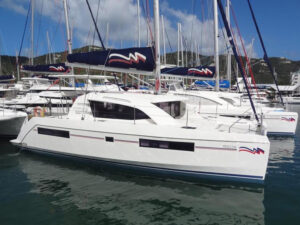
Leopard 40 Prelude Listed For Sale
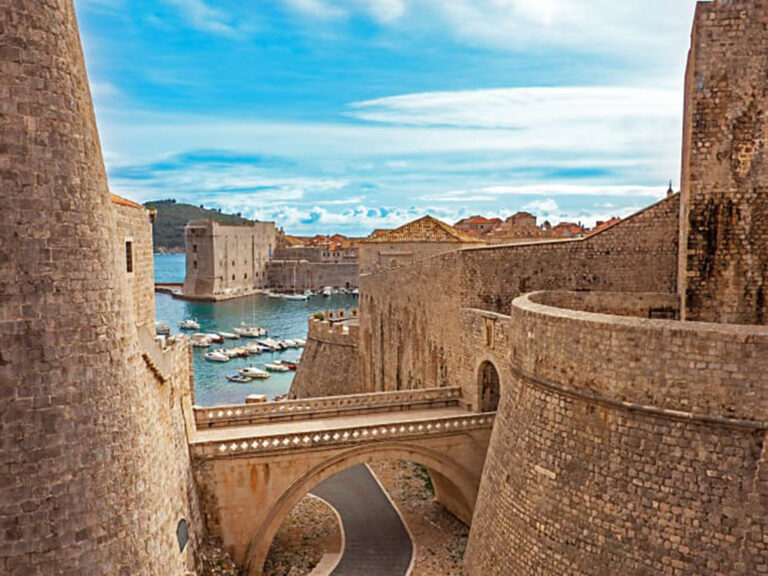
The Moorings Expands in Croatia
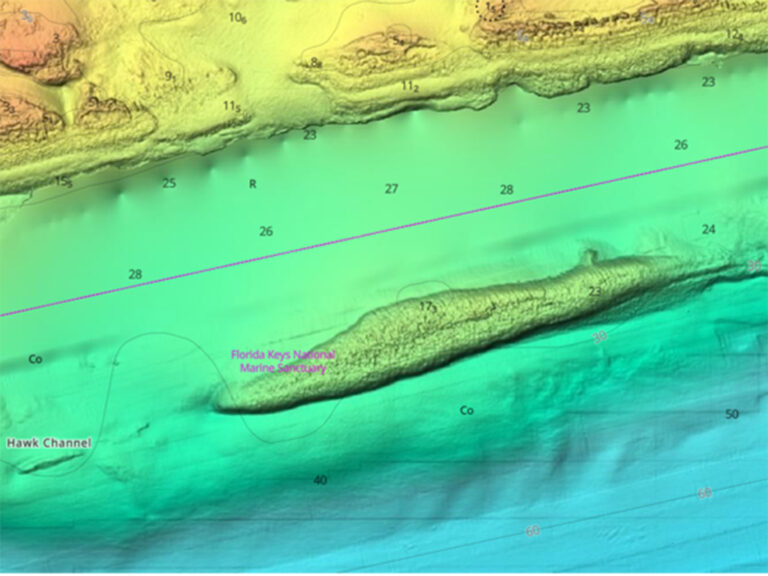
C-Map Updates North America Charts
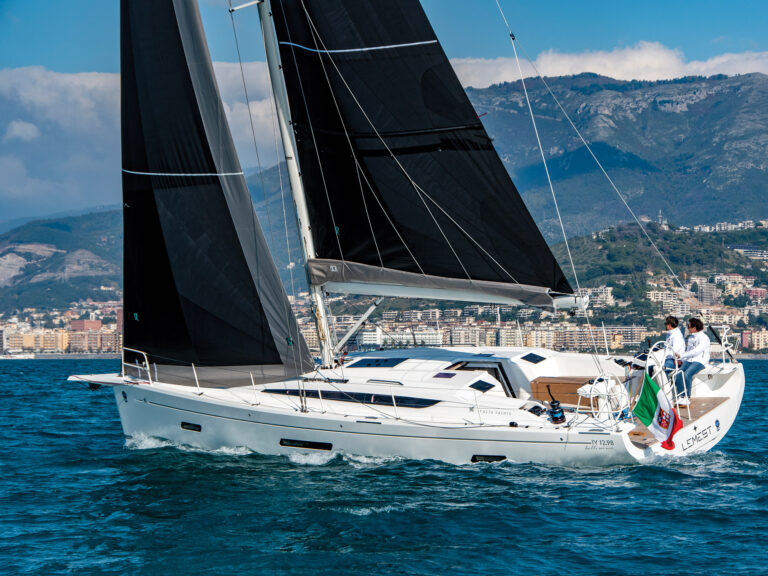
St. Vincent Court Orders Deportation For Hijacking Suspects
- Digital Edition
- Customer Service
- Privacy Policy
- Terms of Use
- Email Newsletters
- Cruising World
- Florida Travel + Life
- Sailing World
- Salt Water Sportsman
- Sport Fishing
- Wakeboarding
Many products featured on this site were editorially chosen. Cruising World may receive financial compensation for products purchased through this site.
Copyright © 2024 Cruising World. A Bonnier LLC Company . All rights reserved. Reproduction in whole or in part without permission is prohibited.
Boat Reviews
- Aquila Boat Reviews
- Aspen Boat Reviews
- Avalon Boat Reviews
- Aviara Boat Reviews
- Axopar Boat Reviews
- Barletta Boat Reviews
- Bayliner Boat Reviews
- Centurion Boat Reviews
- Charger Boat Reviews
- Cruiser Yachts Reviews
- Formula Boat Reviews
- Fountaine Pajot Reviews
- Freeman Boatworks Reviews
- Galeon Luxury Yachts Reviews
- Intrepid Boat Reviews
- Jupiter Marine Reviews
- Manitou Boat Reviews
- Native Watercraft Reviews
- Phenom Yacht Reviews
- Pursuit Boat Reviews
- Sailfish Boat Reviews
- Sea Ray Boat Reviews
- Sea-Doo Watercraft Reviews
- SeaVee Boat Reviews
- Solace Boat Reviews
- Windy Boat Reviews
- X Shore Boat Reviews
- Yamaha Boat Reviews
- Boats Specs
- Marine Pros
- Boat Insurance
- Boat Warranties
- Boat Transport
- Boat Towing
- Marine Forecasts

Your Ultimate Boating Resource

2024 Pursuit OS 445: An Overview
Boat safety 101: exploring the serenity and adventure of boating, the moment of truth – 6 signs you need a new boat, eco-savvy sailing: expert tips for reducing fuel costs and enhancing your boating experience, 2024 aquila 47 molokai review, 2024 sea-doo switch 13 sport review, 2024 aspen c120 review, 2004 hunter 44, 2004 hunter 44 specs.
- Boat Type : Monohull Sailboats
- Quantity: 1
- Horse Power: 56
- Type: Diesel
- Hull Material : Fiberglass
- Beam : 14'6"
- Length : 43'
- Net Weight : 22936 lbs
- Looking for the Boat Manual? 2004 Hunter Boats 44 Request Boat Manual Now

Related Boats
- 2005 Hunter 44
- 2006 Hunter 44
- 2007 Hunter 44
Sea Safety Blueprint: Constructing the Perfect Float Plan for Your Boating Adventures
What type of wood is used for pier pilings, what is the difference between a dock and a floating pier, what is the proper technique for pulling a beginner wakeboarder, what does ‘no wake’ mean on a lake, what is the difference between wash and wake, 10 essential tips for fishing near private property, the benefits of using a drift sock: guidance for anglers, lure fishing: secrets for imitating live bait and attracting fish, explore the untapped depths of america’s best bass fishing spots, tackle your catch-and-release adventures with these 6 tips, outboard motor maintenance: tips for keeping your engine in top shape, the essential boat tool kit: tools every boater needs, diy boat building: 8 tips and tricks for building your own vessel, the art of miniature maritime craftsmanship: ship in a bottle, antifouling paints: a guide to keeping your boat shipshape, beginner’s guide to standup paddle boarding: tips and techniques, boating for fitness: how to stay active on the water, kayak safety: how to stay safe on the water, anchoring in a kayak or canoe: how to secure your small boat, 2024 yamaha 222xd review, 2024 sailfish 316 dc review, 2023 seavee 340z review, 2023 centurion fi23 review, gear reviews, megabass oneten max lbo jerkbait review, fortress anchors fx-7 anchoring system review, fortress anchors fx-11 anchoring system review, fortress anchors commando anchor kit review, fortress anchors aluminum anchors review, stay in touch.
To be updated with all the latest news, offers and special announcements.
- Privacy Policy
- New Sailboats
- Sailboats 21-30ft
- Sailboats 31-35ft
- Sailboats 36-40ft
- Sailboats Over 40ft
- Sailboats Under 21feet
- used_sailboats
- Apps and Computer Programs
- Communications
- Fishfinders
- Handheld Electronics
- Plotters MFDS Rradar
- Wind, Speed & Depth Instruments
- Anchoring Mooring
- Running Rigging
- Sails Canvas
- Standing Rigging
- Diesel Engines
- Off Grid Energy
- Cleaning Waxing
- DIY Projects
- Repair, Tools & Materials
- Spare Parts
- Tools & Gadgets
- Cabin Comfort
- Ventilation
- Footwear Apparel
- Foul Weather Gear
- Mailport & PS Advisor
- Inside Practical Sailor Blog
- Activate My Web Access
- Reset Password
- Pay My Bill
- Customer Service

- Free Newsletter
- Give a Gift

How to Sell Your Boat

Cal 2-46: A Venerable Lapworth Design Brought Up to Date

Rhumb Lines: Show Highlights from Annapolis

Open Transom Pros and Cons

Leaping Into Lithium

The Importance of Sea State in Weather Planning

Do-it-yourself Electrical System Survey and Inspection

Install a Standalone Sounder Without Drilling

Rethinking MOB Prevention

Top-notch Wind Indicators

The Everlasting Multihull Trampoline

In Search of the Snag-free Clew

What’s Involved in Setting Up a Lithium Battery System?

Reducing Engine Room Noise

Breaking Point: What Can Go Wrong With Your Yanmar?

Mildew-resistant Caulks for Boats

Can We Trust Plastic Boat Parts?

Repairing Molded Plastics

Mailport: Marine plywood, fuel additives, through bolt options, winch handle holders

The Day Sailor’s First-Aid Kit

Choosing and Securing Seat Cushions

Cockpit Drains on Race Boats

Rhumb Lines: Livin’ the Wharf Rat Life

Safer Sailing: Add Leg Loops to Your Harness

Resurrecting Slippery Boat Shoes

Tricks and Tips to Forming Do-it-yourself Rigging Terminals

Marine Toilet Maintenance Tips

Learning to Live with Plastic Boat Bits

The Ultimate Guide to Caring for Clear Plastic
- Sailboat Reviews
Hunter 23.5
This family cruiser is innovative and has lots of room. in gusty winds, however, it is quick to stall..
Hunter Marine Corp. is noted for its slick, innovative and low-cost mass production sailers. The Hunter 23.5, new in 1992, fits the bill in all respects.
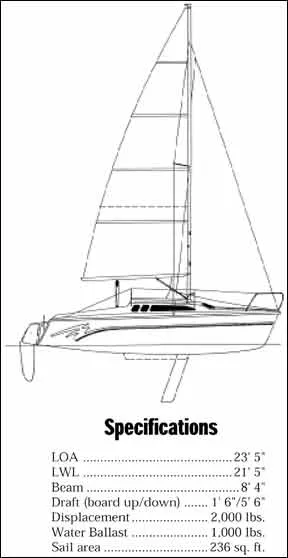
The 23.5 was designed as a trailerable family cruiser for entry-level sailors. Like most Hunters, the boat offers lots of space in the cockpit and down below, and comes with the famous Cruise Pac, which provides just about anything a customer needs, including sails, motor, trailer, lifelines, anchor, life jackets, flares and a copy of Chapman’s Piloting, Seamanship and Small Boat Handling . It’s this type of marketing (plus price: the 1992 price was $13,500) that has helped make Hunter one of the most successful sailboat producers in the U.S.
No one has ever faulted the Alachua, Florida, builder for offering anything but fresh, well-thought out designs. The most striking feature of the 23.5 is its water ballast system, new to Hunter. The system permits an operator to remove 1,000 pounds of ballast from the trailering weight. A retractable centerboard, kick-up rudder and mast that’s fairly easy to step and unstep further enhances trailerability. All told, boat, motor and trailer weigh a combined 2,450 pounds. This model also contains enough foam to provide positive flotation.
While Hunter has enjoyed considerable success with the buying public, it has also suffered from a negative image problem. Earlier PS reviews have criticized Hunter products for a lack of quality control-various systems kinks, lightweight hulls, poor finish work and general absence of blue-water seaworthiness. On the other hand, Hunter owners, while acknowledging a prevailing lack of respect, frequently defend their choice. In the realm of objective data, Coast Guard complaint and recall statistics reveal that Hunter has a better than average record when it comes to hull blistering. (Hunter offers five-year bottom blister warranty protection for the 23.5.) Clearly, the company is doing something right. The model we inspected (hull #8) showed, with very few exceptions, careful attention to detail and finish work in even the least accessible places-more than youd expect on a $13,500 boat. But it is also a boat with some inherent contradictions, in our opinion.
The 23.5 is a highly engineered product with lots of thoughtful features. Hunter, unlike some builders, constructs a mock-up, followed by a prototype that is extensively tested before final design decisions are made. The hull form is modern looking, almost powerboaty in appearance from some angles. Continuing a tendency evident in recent Hunters, the design team has given the 23.5 a relatively full hull, and raised the freeboard to reduce the cabin height, as well as add room below and keep those up top dry in a chop. Because the cabin extends to the rail (no side decks), you must climb over the cabin top to get to the foredeck.
The rig (a B&R design) consists of a 28-foot Z. Spar mast, fractionally rigged with swept-back spreaders that eliminate the need for a backstay (and make un-stepping/stepping, hence trailering, simpler); for the most part, the uppers are aft of the “after” lowers-until deck level-creating a triangular support system. Main and jib halyards are internal and led back to the cockpit. Power comes from a fully battenedmainsail and 110-percent jib (UK Sailmakers-Hong Kong) with a total of 236 square feet. For steering, the traditional wooden tiller has been replaced with a brushed aluminum tube that arches over the walk-through transom (swim ladder comes standard). The aluminum, said chief designer Rob Mazza, weathers better and is easier to arch in order to keep the rudder low and the tiller sufficiently high. Many helmsmen will use the standard Ronstan X-10 tiller extension.
The water ballast/keel system constitutes the key feature of the 23.5. The water ballast-125 gallons, or 1,000 pounds-takes about two minutes to bring on board. The system is activated by flipping up a lid at the base of the companionway, opening a vent and turning a T-valve; the valve in turn drops a circular stainless steel plate aft of the keel, exposing four holes in the hull. (The plate can then be closed flush.) And while you can’t jettison the water downwind, you can swing up the centerboard to reduce draft to 18 inches. The 4-foot centerboard, controlled by the outboard line to the cockpit, moves easily up and down via a cascade block and tackle arrangement.
The apparent thinking of Hunter engineers was to provide a simple, one-step water ballast system that keeps draft shallow while lowering the center of gravity for added stability and righting moment. The ballast-about 16 cubic feet in volume-lies immediately below the waterline. When the water is added, the boat sinks several inches. Nevertheless, while the water adds 1,000 pounds to the overall displacement, its location does not seem to provide sufficient righting moment for windward work in gusty conditions. On racing boats, water ballast is carried above the waterline and outboard under the settees, which of course provides more righting moment. But this water must be pumped into the chambers and drained before tacking-too complicated for Hunter’s purposes.
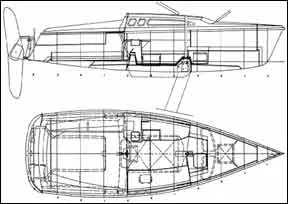
Construction of the boat is fairly straightforward, with balsa in the hull and plywood in the deck. The plywood core has the potential to encourage water migration should a deck leak occur at some point. The deck/hull joint, with a roll similar to a Hobie 18-a “modified shoebox,” one Hunter engineer described it-is bonded with glass and further fastened by flathead screws through the rubrail. Stanchions, fastened to aluminum backing plates that are glassed in, are sturdy. Though not a heavily-built boat, the 23 looks solid enough; in the absence of a graceful hull form-no sheer here-Hunter provides some added dash with a smoked forward-facing window and a green and purple hull swoosh graphic, which apparently has drawn strong reaction, pro and con (We liked it). Oddly, there is no waterline or boot scribed in the hull. Perhaps Hunter anticipates owners dry-sailing the 23.5, but the absence of a waterline mark will make bottom painting a difficult chore the first time.
Performance
We test sailed the 23.5 off Newport, Rhode Island. In light-air conditions, the shallow-body, lightweight boat (displacement 3,000 pounds with the water ballast) moved up to speed quickly. The boat pointed high and the few light puffs we experienced produced no noticeable helm. We did have some problem finding a definitive groove, especially after tacking. The boat glided through the water easily on a reach and downwind, with the board up, sped along as much as a 23-footer can (Mazza said it will surf under the right conditions). We moved relatively faster, in fact, than a Nonsuch 27 on the same tack.
In stronger 15-20 knot winds, it is a whole different experience. With a single reef in the mainsail, the boat consistently rounds up and stalls. In addition to the boat’s higher vertical center of gravity, this tendency may also be due to the very high-aspect ratio centerboard, which is generally associated with quick stall characteristics.
Complicating matters is the way the rig and sheeting are set up. With no backstay (or topping lift) and no traveler, and with the main sheeted down and far forward near the companionway, the main and sheet are highly stressed. And because the cam cleat for the mainsheet is down near the cockpit sole, it’s difficult to reach-especially in heavy air on a beat, when the helmsman and everyone else is out on the rail. The rounding up and stalling require constant spilling of the main. This may be okay (if tiring) for the experienced sailor, but a bit strenuous and nerve-wracking for the beginner at whom this boat is marketed.
Instead of a single reef, one solution might be to take a second reef in the main in anything approaching 15 knots, but that’s not much of a solution. With 236 square feet of sail-128 in the main, 108 in the foretriangle-for a sail area-displacement ratio of 18.9, the boat should not be overpowered. (The O’Day 23, of about the same displacement, but with 200 more pounds of ballast, carries 246 square feet)
Another solution, although it breaks up the cockpit, might be a barney post where there’s already a slot for the cockpit table, a system that worked well enough in the Alerion-Express. A traveler would be even better, though obviously Hunter wanted to keep the cockpit clear of obstructions as well as avoid the added cost.
Accommodations
You get a lot for your money with this Hunter model. One thing you get a lot of is interior space or, as company literature describes it, “a 25-foot boat in a 23.5 hull.” The main cabin is sizable and has more headroom than we’ve seen on a 23-footer. A pop-top hatch allows those down below to stand up in the center of the cabin. An optional canvas camper top ($300) provides protection from the elements. Poptops are notoriously leaky, and we can’t vouch for this one’s water tightness; however, Hunter has provided drains all around.
The smoked pop-top, plus three ports per side in the main cabin (two small circles, one longer swoosh-style forward) and the forward-facing window provide plenty of light. Hunter has made no attempt to yacht-up the interior: What you get is a basic cream-colored liner, offset on a portion of the topsides by a close-weave grayish fabric someone called “monkey fur.” Despite the plainness, we liked the clean look of the interior.
Aft to port in the main cabin you get a galley station with a one-burner alcohol stove, sink, and fold-out table with storage below. You won’t be whipping up any Cruising World -style feasts in this galley, but it’s nice to be able to heat up some coffee or a cup of soup. Forward of the galley is a small settee/berth, sized right for a child, with storage beneath and a cutout for a portable ice chest. Opposite is a somewhat longer settee/berth of less than six feet, with more storage and a battery compartment below. On the centerline is a slot for a small table that also can be set up in the cockpit.
There are a number of helpful additions: an automatic bilge pump, access plates underneath the cockpit winches. The portable toilet is located to starboard behind a half-bulkhead and privacy curtain, and under the V-berth. Aside from the standard V-berth in the bow, which seems a bit cramped, there’s a double berth (plus stowage) aft of the main cabin, under the cockpit and seats (not for the claustrophobic). It was back here in the bowels of the boat that we spotted the only untrimmed fiberglass.
On deck, there’s an equally roomy cockpit-7′ 9″ long and 6′ 2″ from coaming to coaming. The relatively wide beam makes the addition of a ridge along the centerline for use as a footrest a welcome touch. Foam padding on the seatbacks is another. A lazaret on either side provides on-deck stowage. There’s a #8 Barient winch on either side of the cabin top, each with an attendant cleat. Lines are meant to be kept in the no-name stoppers to starboard. Because of the profusion of lines led back on the starboard side, we’d prefer an extra cleat and winch.
Nonskid is molded in. The foredeck holds an anchor locker, which also contains a padeye for the stepping/unstepping operation. Skipping the details of this procedure-which involves use of a gin pole, the main and jib halyards and a bridle that controls lateral movement-we’d say that Hunter has devised as easy a way to drop a mast as is possible. Once down, the forward end rests in a U-shaped bend in the bow pulpit, the aft end on a roller-topped pole fitted at the transom.
Conclusions
In its attempt to create a simply operated, easily trailered, entry-level boat at a good price, Hunter has come up with some clever compromises. But they are compromises just the same. The 23.5 sails well on all points in light air; it does well off the wind in heavier air. Windward work over 15 knots in this boat is poor in our estimation. We’d strongly recommend that potential customers thoroughly test sail the boat in a variety of wind conditions, experimenting with one or two reefs, to be certain it’s something they’re able-and willing-to handle.
The Hunter 23.5 is clearly striking a chord with some buyers, and assuming many are entry-level sailors, we think it’s great that this boat is attracting newcomers to the sport. The design represents a clever way of managing the trailering problem (i.e., weight and draft). At the same time, we can’t help but wonder if its behavior in gusty winds is worth the convenience of dumping ballast on the launch ramp.
RELATED ARTICLES MORE FROM AUTHOR
excellent article.
Darrell – excellent review. Thanks.
Thanks for the review, I just saw one for sale online.
LEAVE A REPLY Cancel reply
Log in to leave a comment
Latest Videos

Island Packet 370: What You Should Know | Boat Review

How To Make Starlink Better On Your Boat | Interview

Catalina 380: What You Should Know | Boat Review
- Privacy Policy
- Do Not Sell My Personal Information
- Online Account Activation
- Privacy Manager

IMAGES
VIDEO
COMMENTS
It comes down to a bit of fact and personal opinion, but that's my opinion. Hunter is a very well-known brand of sailboats. Hunter sailboats are a good boat depending on your needs and what you will be using your boat for primarily. They were designed as a more budget-friendly boat with all of the basic features needed for good coastal cruising.
The Hunter water ballast sailboats were designed for the trailerable sailor as I was very much involved with them from the start. The 23.5 is my baby and I outsold all other dealers of the 240. I also sold Catalina, Beneteau, ComPac, Precision, MacGregor and many others over the years. I have heard all the Fiddlesticks about boats and so on.
The Hunter 44 Deck Salon is a big-volume hull with a higher coachroof profile than its sister (the Aft Cockpit Cruising Version). It has a fin keel (shallow draught is an option) and features the deck-stepped B&R rig, with swept-back spreaders and plenty of diagonal support.
Hunter 44 stern view, showing transom details and enclosed cockpit with dodger and Bimini top combination. The Hunter 44 is a development of the 2002-introduced Hunter 426 DS, with a redesigned aft cabin. The Hunter 44 design was developed into the Hunter 45 DS in 2008 with the addition of twin helms, redesigned forward berth and new cabin windows.
Buy Now. $164,900.00. This 2007 44 Deck Salon features great headroom, with a very large salon, an L shaped galley, 3 staterooms each sleeping 2 people, and 2 heads, each with shower stalls. The boat is very well laid out and ready to have the last few details finished before Caribbean cruising! It is in Melbourne, FL on the intracoastal ...
This is my second post on this forum and I wanted to first say hello . My wife and I are going to look at a 2004 Hunter 44 Deck Salon as a perspective first boat for us and our two kids. I have already taken all my ASA classes up to 104 and I'm confident about sailing this size of boat but I was wondering aside from my online search for reviews ...
Get the latest 2006 Hunter 44 DS boat specs, boat tests and reviews featuring specifications, available features, engine information, fuel consumption, price, msrp and information resources. ... Boat Reviews. Boat Reviews 2024 Pursuit OS 445: An Overview. Aquila Boat Reviews 2024 Aquila 47 Molokai Review. Boat Reviews 2024 Sea-Doo Switch 13 ...
Re: 2004 Hunter 44 Deck Salon any opinions or experiences? Great! That will be a really good boat which will hopefully bring you more sailing and cruising joy than fixing joy. You may have avoided the trap of buying the biggest cheapest boat out there only to find the project list is more endless than on a usual boat.
Sailing upwind at about 40-degrees apparent, the 45-foot, 23,000-pound cruiser always topped 5 knots and sometimes 6, despite its three-blade prop. Downwind, we set a cruising spinnaker and logged more than 7 knots, jibing through 90 to 100 degrees. It was a smooth and satisfying sail, aided by the responsive Lewmar steering, which has direct ...
With its 54-horsepower Yanmar auxiliary turning a fixed, three-blade prop, the Hunter 45DS topped 8 knots at 3,000 rpm in flat water and little current. Add some wind and sea, and the 75-horsepower option becomes attractive. The combination of a large rudder and relatively short keel gives the 45DS good maneuverability.
Hunter 44DS Sailboat: s/v Groovy. Groovy has been sold. Pics, listing and Sales Spec Sheet here!! Groovy (named for Simon & Garfunkel's song Feelin' Groovy )** is a. Glenn Henderson designed 2008 Hunter 44DS (Deck Salon). fractional sloop, it is 44 feet long and 14' 6" feet wide with two. staterooms and two heads.
Boat Reviews. All Jupiter Marine ... 2007 Hunter 44 Specs. Boat Type: Monohull Sailboats; Engine Specifications. Quantity: 1; Horse Power: 56; Type: Diesel; Hull Material: Fiberglass; Beam: 14'6" Length: 43' Net Weight: 22936 lbs; Looking for the Boat Manual? 2007 Hunter Boats 44. Request Boat Manual Now.
Sailboat Reviews. All Multihulls New Sailboats Sailboats 21-30ft Sailboats 31-35ft Sailboats 36-40ft Sailboats Over 40ft Sailboats Under 21feet used_sailboats. Cal 2-46: A Venerable Lapworth Design Brought Up to Date. ... And that's important when you are buying a Hunter or any other boat. Practical Sailor is different. Its candor is as sharp ...
The Hunter 426 DS tempts a broad audience with comfort, agility, and price. On a morning last February, when half of the country was getting hammered by another winter storm, I was coasting off Miami Beach aboard the new Hunter 426 Deck Saloon (DS) sloop. Sunburn was my biggest concern. As if that weren't enough reason to feel smug, the 426 ...
Aug 4, 2013. Hunter Marine—now known as Marlow Hunter —celebrated its 40th birthday and a recent change in ownership by introducing its latest mid-size cruising boat, the new Hunter 40, in something of a hurry last fall. The rush from design to production took all of eight weeks, and hull #1 made it to Annapolis just in time for a ...
The Hunter 45 DS Has Aged Remarkably Well. Yep, another used sailboat review of a 40-something Deck Saloon, this time a domestically built boat from Hunter. Earlier in the month I had the opportunity to survey a 2008 Hunter 45 Deck Saloon (DS). At the end of the day after reviewing the results with the potential buyer, I realized that the deficiency list was small, and the boat had aged ...
It takes into consideration "reported" sail area, displacement and length at waterline. The higher the number the faster speed prediction for the boat. A cat with a number 0.6 is likely to sail 6kts in 10kts wind, a cat with a number of 0.7 is likely to sail at 7kts in 10kts wind. KSP = (Lwl*SA÷D)^0.5*0.5
Find Hunter 44 boats for sale in your area & across the world on YachtWorld. Offering the best selection of Hunter boats to choose from.
Find Hunter 44 Deck Salon boats for sale in your area & across the world on YachtWorld. Offering the best selection of Hunter boats to choose from.
Aug 21, 2017. Original: Aug 22, 2014. A Big Little Sistership: An able 37-foot cruiser with lots of space and an easy-to-handle rig. The Hunter 37 is effectively a smaller sistership to the Hunter 40, which was introduced in something of a rush in 2012 as Marlow Hunter—formerly Hunter Marine—celebrated its 40th birthday and a change of ...
There are currently 28 listings available on Boat Trader by both private sellers and professional boat dealers. The oldest boat was built in 2004 and the newest model is 2007. Related boats include the following models: Passage 420, 33 and 380. Find 28 Hunter 44 Boats boats for sale near you, including boat prices, photos, and more.
Boat Reviews. All Jupiter Marine ... 2004 Hunter 44 Specs. Boat Type: Monohull Sailboats; Engine Specifications. Quantity: 1; Horse Power: 56; Type: Diesel; Hull Material: Fiberglass; Beam: 14'6" Length: 43' Net Weight: 22936 lbs; Looking for the Boat Manual? 2004 Hunter Boats 44. Request Boat Manual Now.
Hunter 23.5 Specs. The 23.5 was designed as a trailerable family cruiser for entry-level sailors. Like most Hunters, the boat offers lots of space in the cockpit and down below, and comes with the famous Cruise Pac, which provides just about anything a customer needs, including sails, motor, trailer, lifelines, anchor, life jackets, flares and a copy of Chapman's Piloting, Seamanship and ...